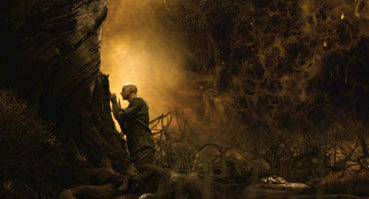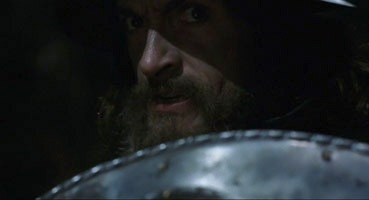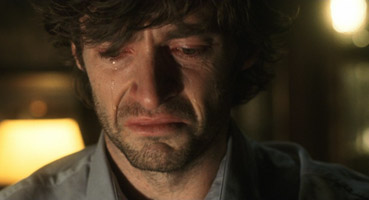|
Darren
Aronofsky's The Fountain was as eagerly
awaited as it was long awaited. Budget and cast problems
delayed the project by several years, and there was a time
it seemed doubtful Aronofsky's big vision would ever hit
the screen. Yet in 2005 the project was resurrected with
a smaller budget and Hugh Jackman and Rachel Weisz replacing
Brad Pitt and Cate Blanchett in the leading roles. It was
within these parameters that the film was able to be completed
and finally released in 2006, four years after its initial
filming schedule.
So,
a labour of love it most certainly is. And watching the
film it definitely does not seem to be a piece that has
been thrown together without much consideration. It is an
intricately conceived work of substance that far transcends
any mere plot description. That is why I love it! Any film
that defies a simple synopsis is always a source of fascination
to me, even if the end product may not satisfy in the same
way as a conventional work. The thing is, it does have a
generic theme, The Fountain is a love story.
It is also a work of science fiction and a meditation on
existence and religion. Basically, its themes are about
as big as you can get. Their handling is anything but conventional
though. I will endeavour to throw some light on the plot
without desecrating the work...

The
film takes place over three different timelines; 16th Century
Spain, present day America and far future space. All three
revolve around a similar character played by Hugh Jackman
and a parallel romantic figure played by Rachel Weisz. In
narrative terms each follow a journey. The first is a quest
to find the tree of life, the second a professional and
personal race against time to find a cure for cancer, and
in the third part a more ambiguous and minimal narrative
shows the journey of an exospheric space craft containing
the Jackman character and the tree of life passing through
a nebula. All three of these intersect each other throughout
the film and although the flow may seem disorientating at
the beginning as you get used to Aronofsky's rhythm and
pace, a certain amount of clarity emerges.
This
film is in some ways very different from his first two features.
Both Pi and Requiem for a Dream
deal with microcosms, thematically and in style. Pi
studies the troubles one man has when he discovers the secret
equation to the universe. That is a pretty big discovery,
but the film is really about the character and how mathematics
could be the key to understanding much of the life we live.
The Fountain is an altogether larger work,
but it shares more thematic similarities with Pi
than with Requiem For a Dream in which
Aronofsky uses his unique directorial abilities to interpret
a book by someone else, whereas his other two features have
both been straight out of his own imagination (in The
Fountain's case, with a little help from Ari Handel).
The Fountain comes into its own most obviously
with its pacing. Aronofsky rejects his high octane editing
techniques and flashy camerawork he has become known for
in favour of a more considered and mature approach. There
is little in the way of tightly edited fast paced scenes
with many short shots, most of The Fountain
plays out in as grandiose a way as the story dictates.
But
what it does share with his previous pictures is a fabulously
artistic eye. The cinematography by Aronofsky regular Matthew
Libatique is breathtaking from start to finish, and I am
hard pushed to find a single scene that does not contain
something truly special in mise en scene. Aronofsky and
Libatique have shown us the beauty in the ordinary, and
sometimes vulgar, with their first two films, and that is
taken care of masterfully in the present day section of
The Fountain. But it is in the larger scale
scenes that they have never been able to film together until
now, where we see the scope and capability of Darren Aronofsky's
vision. Form truly meets content with the huge tree of life,
the towering Mayan temple, and in the expanses of outer
space, all of which frame Jackman's character, the symbol
of humanity, next to them to truly illustrate scale. Technically,
the budget constraints faced on the production forced Aronofsky
to incorporate macro photography with computer generated
effects. This lends a strange injection of reality into
the on-screen effects, creating another layer to the visuals
that pure CG would not have attained, as well as watering
down the CG that is so often overpowering in today's big
budget pictures.

I
believe, like many a film, this work owes much to Joseph
Campbell's concept of the 'Hero with a Thousand Faces'.
Each section of the narrative triptych is a clear journey
from A to B, even if it is not always clear where the journeys
end and the resolution may be. It is in these doubts and
mild confusions that the hooks of the film reside.
Thankfully, the answers to such questions are never fully
explained, thus leaving room for speculation, and there
has already been a lot written about the film's possible
meanings. It is enigmatic in a way that may steer some towards
David Lynch comparisons, although there is less surrealism
in The Fountain than in Lynch's more abstract
narratives but more direct symbolism and recurring motifs.
The semiotics revolve around light and dark, life and death
and the passage from one to the other. Religion as a basis
for existence is explored as the film opens with a bible
quote and there are allusions to many religions other than
Christianity, most prevalently Buddhism. The entire piece
moves from dark to light, towards enlightenment, and the
two main characters depicted in each segment could be read
as reincarnated versions of the same souls. The direct facing
of death by Weisz's present day character reflects the direct
facing of eternal youth by Jackman's conquistador in the
past. Although this is not the only reading, as the past
is fictional in the world of the film (a book being written
by the present day Weisz) and it is possible the final section
is purely symbolic, thus rendering the present day world
the only 'real' one. But this is all for the subjective
audience to decide themselves. Aronofsky has compared the
movie to a Rubick's Cube with one real solution, but many
different ways of getting to it. I like that idea very much.
The
performances are excellent across the board (with a welcome
supporting role from Ellen Burstyn), with the real accolade
going to Hugh Jackman, who gives a mature enough performance
to convince all that there is life after Wolverine. And
I couldn't wrap up this review without mentioning the sublime
soundscaping created by Aronofsky's usual composer, Clint
Mansell. I love his work and it is great to see a Brit musician
thriving on Hollywood soil! He was also helped in the score
by the post rock band Mogwai, which I am also glad to hear
of as I have thought since first hearing them some years
back that they were destined for film scoring. Their distinctive
sound coupled with Mansell's sometimes Philip Glass-esque
scoring is yet another reason why this film has become a
recent favourite of mine.

The
Fountain is a wonderful achievement that may surprise
some Aronofsky fans, but if persevered with it reaps great
rewards. A treat for the eye and mind alike, this is a milestone
for an already great director and in a perfect world I could
see this being to Aronofsky what 2001: A Space Odyssey
was to Kubrick. At least it deserves to be!
The
Fountain is sometimes visually a dark film with
an extensive use of low key lighting, traditionally a challenge
for DVD encoding if you are going to avoid loss of detail
while retaining black levels and contrast, but this 20th
Century Fox disc delivers the goods, although a darkened
room is recommended to get the best out of it. The framing
is 1.85:1 and the picture is anamorphically enhanced.
The
Dolby 5.1 soundtrack has very nice separation with effective
use of the surrounds and the occasionally burst of LFE bass
to keep the subwoofer exercised. Clint Mansell's score sounds
particularly impressive.
Inside
The Fountain: Death And Rebirth – 7-part documentary
This is basically one documentary split into 7 parts to
make the DVD special features look more impressive. An enlightening
and interesting documentary, Death and Rebirth
covers the project from conception to production and has
many mini interviews with Aronofsky, Libatique and other
crew and cast members as well as on set footage. The last
part consisting of an interview with Jackman conducted by
Rachel Weisz on the last day of shooting is a nice addition,
although I think it serves as a separate featurette to the
rest of the documentary.
Life
On Ship extended sequence
An extended scene of Jackman's future character onboard
the exospheric craft. A beautifully other worldly sequence
with dreamlike soundtrack that would make a wonderful short
arthouse film on its own.
Trailers
The usual. As a cynic to the inclusion of these things on
DVDs I am not the best person to comment on the trailers.
Exactly what you would expect from a studio trying to push
a 'difficult' movie to a wider audience.
Darren Aronofsky himself has expressed disappointment with
this DVD package and is pushing for a commentary track on
an as yet unconfirmed Criterion edition of the film, which
will hopefully surface in the near future with a set of
features more worthy of the film.
|